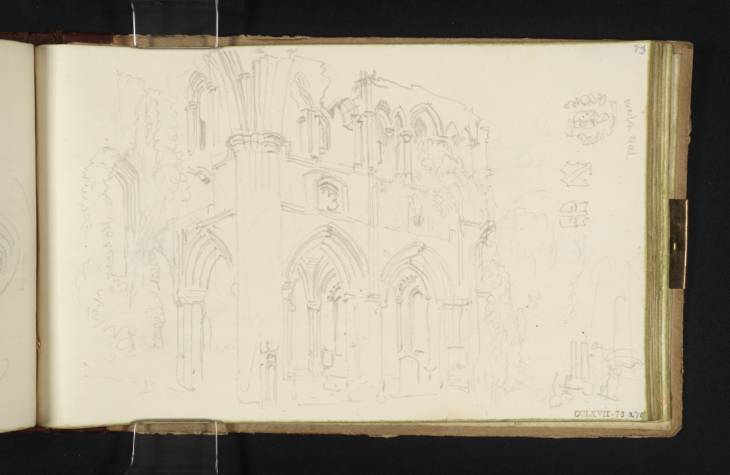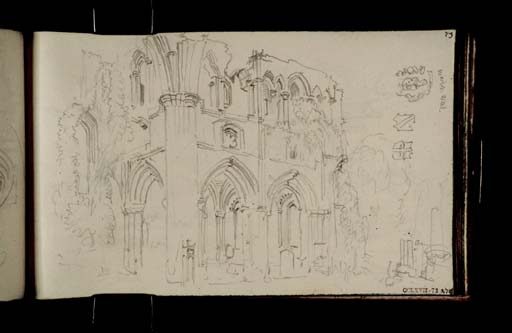J.M.W. Turner
>
1830-35 Annual tourist
>
Scotland 1831
>
Abbotsford Sketchbook
>
Artwork
Joseph Mallord William Turner Ruins of Dryburgh Abbey 1831
Image 1 of 2
Joseph Mallord William Turner,
Ruins of Dryburgh Abbey
1831
Joseph Mallord William Turner 1775–1851
Folio 71 Recto:
Ruins of Dryburgh Abbey 1831
D26054
Turner Bequest CCLXVII 73
Turner Bequest CCLXVII 73
Pencil on off-white wove writing paper, 113 x 185 mm
Inscribed in pencil by Turner ‘Watch well’ top right descending vertically
Inscribed in blue ink by John Ruskin ‘73’ top right and ‘271’ bottom right
Stamped in black ‘CCLXVII – 73’ bottom right
Inscribed in pencil by Turner ‘Watch well’ top right descending vertically
Inscribed in blue ink by John Ruskin ‘73’ top right and ‘271’ bottom right
Stamped in black ‘CCLXVII – 73’ bottom right
Accepted by the nation as part of the Turner Bequest 1856
References
1909
A.J. Finberg, A Complete Inventory of the Drawings of the Turner Bequest, London 1909, vol.II, p.859, CCLXVII 73, as ‘Ruins of Dryburgh Abbey.’.
1972
Gerald E. Finley, ‘J.M.W. Turner and Sir Walter Scott: Iconography of a Tour’, Journal of the Warburg and Courtauld Institutes, vol.35, 1972, p.382 note 137.
This detailed drawing shows the Presbytery of Dryburgh Abbey, which is still in much the same state today, although less overgrown. Robert Cadell, the publisher to Sir Walter Scott’s works, accompanied Turner to the abbey. Turner may have already been aware that Cadell had rejected the proposal of an illustration of the spot where Scott was to be buried in the abbey (a side chapel near the remains of the north transept),1 and thus determined on a more distant view of the ruins, as in the sketch across folios 8 verso–9 (D25941–D25942; CCLXVII 8a–9). Turner may therefore have been drawn to these ruins purely for their personal interest and picturesque nature.
Other sketches on the page may also have a commemorative as well as documentary purpose. At the outer edge with the sketchbook turned to the left are sketches of three shields. These were drawn from relief carvings of coats of arms in the side chapels. The one at the left is a rather ornate carving with a carved helmet above, and a shield surrounded by leaves with the inscription in a scroll above it reading ‘WATCH WEELL’ which Turner has copied out. The two shields to the right of this are both found on a terracotta coloured plaque with a long Latin inscription that is located nearby. The location of these carvings near tombs in a side chapel of Dryburgh may have reminded Turner of Scott’s burial arrangements, and the author’s mortality; he was in a poor state of health and died the following year.
There are further close-up studies of Dryburgh on folios 71 verso–73 verso (D26055–D26059; CCLXVII 73a–75a).
Thomas Ardill
September 2009
How to cite
Thomas Ardill, ‘Ruins of Dryburgh Abbey 1831 by Joseph Mallord William Turner’, catalogue entry, September 2009, in David Blayney Brown (ed.), J.M.W. Turner: Sketchbooks, Drawings and Watercolours, Tate Research Publication, December 2012, https://www


